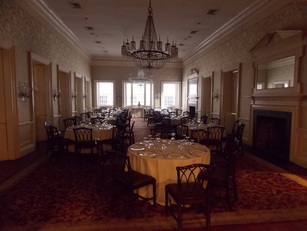 Second portrait of George Washington painted by John Trumbull
Second portrait of George Washington painted by John Trumbull
It is with George Washington's first tour of the southern states on horseback that we focused our visit. We explored the trail of Washington by touring the Heyward-Washington house which he rented for his eight day stay in Charleston. We also explored the Old Exchange building where Washington attended a grand ball in his honor. Washington remarked in his diary that the women were "elegantly dressed and handsome ladies".
My favorite story started in the Exchange. After Washington's visit, the City Councilmen commissioned John Trumbull to paint a portrait of Washington to commemorate the visit. Trumbull painted a seven-foot royal portrait of Washington but, much to the Councillors dismay, had Washington posed in front of the city of Trenton, NJ. Councillors refused to pay Trumbull for the portrait, so Washington stood for a second portrait, this time featuring Charleston in the background. Trumbull got his revenge on the Councillors, however, by inserting a laughing horse behind the President, with the horse's butt prominent and its tail strategically raised over the city and its council in direct line of fire! We had to go to city hall to see the original of this caustic portrait.
My favorite story started in the Exchange. After Washington's visit, the City Councilmen commissioned John Trumbull to paint a portrait of Washington to commemorate the visit. Trumbull painted a seven-foot royal portrait of Washington but, much to the Councillors dismay, had Washington posed in front of the city of Trenton, NJ. Councillors refused to pay Trumbull for the portrait, so Washington stood for a second portrait, this time featuring Charleston in the background. Trumbull got his revenge on the Councillors, however, by inserting a laughing horse behind the President, with the horse's butt prominent and its tail strategically raised over the city and its council in direct line of fire! We had to go to city hall to see the original of this caustic portrait.

The fragrant white flower vines, and Spanish moss covered tree lined neighborhoods of perfectly preserved colonial homes provided the perfect ambiance making us feel like we had strolled back through time where we found McCrady's tucked back on the brick lined Unity Alley. As we stepped through the door under a quaint wrought iron gas lamp sign, McCrady's did not disappoint. It is actually the outside of two buildings closed in with 3 large brick arches that were once open bays along the left, housing a romantic booth in each. On the right was a long elegant wooden bar with a wine cache above to be reached by a library style rolling ladder. You could look up and see the once outside windows above in this cavernous room. Sam, our bartender served me the uniquely tasty Marcona time out, and Bruce sipped an equally interesting Incan affair. These delicious drinks put us perfectly in the right frame of mind to absorb some history!
 The famous long room on the second floor where George Washington dined.
The famous long room on the second floor where George Washington dined.
This building had originally been purchased by Edward McCrady in 1778, as a Tavern. Two years later, when Charleston surrendered to the British, McCrady had been taken prisoner and sent to St. Augustine, FL where he was held for a year before his release. Coincidentally, our visit marked the 235th anniversary the siege of Charleston, where Major General Benjamin Lincoln of the Continental army surrendered to the very day. This didn't stop McCrady from eventually returning to his tavern and building on to it including an elegant long room on the second level where music, dancing, and shows were performed. McCrady's was not the local dive pub of the old city, but the destination for the city's upper crust members. George Washington himself was hosted at the Cincinnati Society dinner complete with music and dancing in the long room, where it is said they enjoyed a 30 course meal.

Another interesting old bar we found while in Charleston was The Blind Tiger Pub. This Charleston landmark was built in 1803 as a bank building and is right in the heart of the historic district. The bar had a 19th century colonial ambiance with a fun heritage. The name came from the dispensary act put into effect in 1893 by governor Benjamin Tillman. The act was an attempt to restore the dignity of the city by state control of all alcohol sales. Charlestonians responded by paying for entrance to see a blind tiger where the alcohol was included in the fee. The fictional blind tiger never appeared but patrons would leave "blind drunk".
 RSS Feed
RSS Feed
